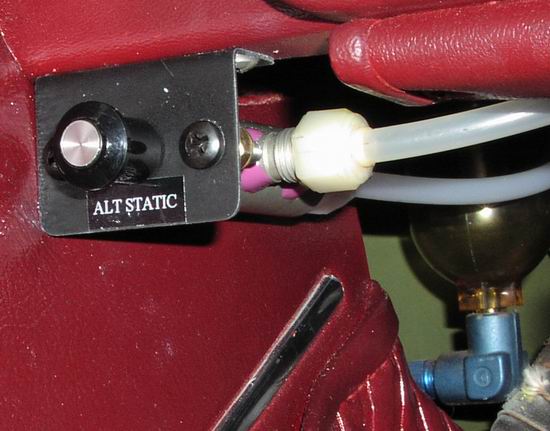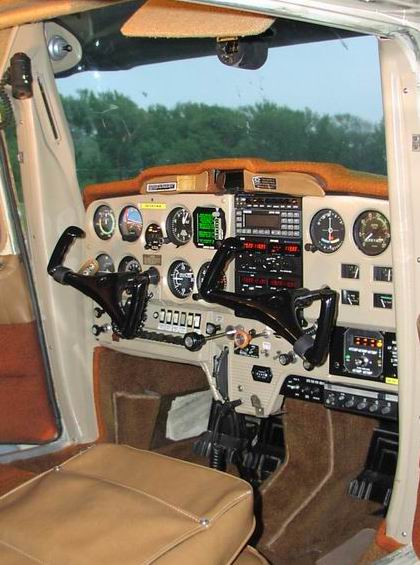Alternate Static Valve:
Cheap Insurance

The kind of day you train for...
I used to fly a Cessna 150 on a route from New Jersey to eastern Massachusetts on a regular basis. I knew the aircraft well and helped to update its avionics compliment from a single Cessna ARC nav/comm to an IFR-capable dual digital flip-flop nav/comm setup with GPS, Argus moving map display, and two-axis autopilot. Needless to say, in its day, this aircraft had everything the serious IFR pilot needed to get around...except maybe the power, load hauling, and speed necessary for longer trips...none of which stopped me from flying it in solid IMC.
One afternoon I was making my way up to Mass in IMC in smooth air at 7000 feet on V167 enroute to the Providence, RI VOR when I noticed the airspeed, VSI, and altimeter "stick" for a fraction of a second. As I was in a solid stratus with a bit of light rain, I didn't think much of it. In fact, I had experienced this "blip" before in this and other aircraft while in rain, and had always assumed it was the result of an errant water droplet hugging the side of the airframe and loitering over the static port.
 Then, a few minutes
later, the unthinkable happened.
Then, a few minutes
later, the unthinkable happened.
At some point during my scan, I glanced at my altimeter and saw I was about 100 feet low. I instinctively applied a subtle amount of backpressure to the yoke to correct the error. After I began pulling, I found it strange that the altimeter didn't react as quickly as it normally did, but at that instant, again, I didn't think much about it because I would often get into areas of sink and it would sometimes take a bit more aggressive pressure on the yoke and maybe a touch of power to correct the altitude error.
Within a second or two, it became rather clear to me that my actions were having no effect. The altimeter, VSI, and airspeed were frozen. I decided to push a bit on the yoke to see if I could command a descent, but...no dice. I instantly thought "great, my static system is plugged, I'm solid IMC, and while I'd trained with partial panel, I'd never trained with these instruments inoperative (and no surprise...losing them is a real emergency). Then my heart sank. After $25K and several weeks' worth of avionics work (not to mention a brand-new "basic six", we'd never thought to install one of the most critical backup systems an airplane can have: an alternate static source valve.
Of course, everyone that had a hand in making this ship IFR-worthy weren't completely at fault. You see, at the time, there was no FAR that stated we needed a valve to legally operate the aircraft under IFR.. Today, FAR 91.205 lists the equipment our aircraft need for IFR flight, but a backup system that may be used to restore static pressure in the event of an emergency is conspicuously absent from that list.
This comes as no surprise, however. As any instrument-rated pilot will tell you, there IS a relatively easy (albeit destructive) way to restore air to the static system in the event the static system becomes plugged -- just break the VSI glass (or perhaps more delicately, the seal between the glass and the instrument case). Sure, it will cost you a $250 instrument, but at least you'll be alive to pay the bill.
After about 15 seconds of soul searching, I decided to call ATC and tell them about my predicament. As I recall, our dialogue went something like this:
Me: Providence Approach, Cessna 345, Urgent Request.
Providence Approach: Cessna 345, go ahead.
Me: I'm in IMC and I've had a instrument system malfunction that has rendered my altimeter, airspeed indicator, and vertical speed indicator inoperative. I'm unable to determine my altitude. I am able to maintain aircraft attitude, however, so I'd like to get an immediate clearance to descend to MEA in an attempt to get to VFR conditions.
Providence Approach: Cessna 345, roger. Descend and maintain 3000. Are you declaring an emergency?
Me: Cleared down to 3000. And, no, I am not declaring an emergency at this time, but if things worsen, I'll definitely let you know.
Providence Approach: Cessna 345 roger, keep me advised. Again, your cleared down to 3000.
Practice Makes Perfect
At this point, I instinctively remembered my instrument training. Pitch plus power equals performance. Set descent power and a pitch attitude, and a predictable descent will follow. And so I did exactly that...carb heat on, power back to 1800RPM, reset my approach timer to count up, and then...sit back and watch the fun. Needless to say, it was quite strange to watch the instruments contradict themselves, but interestingly, I found it quite easy to fly the aircraft in this condition. I never realized how little I relied on these instruments during descent operations, because I *always* set up descents this way.
About 5 minutes later, I popped out of the overcast and into more or less clear air at about 3500 feet. How did I know the altitude? Well, as luck would have it, in about 30 seconds after clearing the clouds, the instruments suddenly came alive: the airspeed snapped to attention, the altimeter unwound to 3500 feet almost instantly, and the VSI pegged down for a few moments, and then slowly returned to 0, as if to say "okay, we've had enough fun with you!". Relieved to be in clear air, I called Providence and told them to cancel IFR and requested advisories to my destination, KTAN, a mere 20 miles east of Providence.
Diagnosis Inconclusive
When I got on the ground, I taxied the aircraft to the local maintenance hangar to have them check it out. We took out the vapor bottle (which looks like the one in the picture, above), and blew it and the (now disconnected) static port out with compressed air. Although I expected to see the bottle full of water or some huge chunk of crud come out of the bottle, everything looked perfectly clean. Once we buttoned it back up I I resolved to fly home as scheduled in a few days. When that day arrived, I took the aircraft on a quick test hop around the pattern and found everything operating normally. Since the weather was good VFR and the instruments appeared to be working fine, I decided to fly the trip IFR for practice, but was fully prepared to cancel IFR or change plans to avoid going into the clouds until I could have our mechanic at home take a closer look at things.
When I got home, I suggested to my friend and aircraft owner to get an alternate static source valve kit installed, but for reasons I can't recall, we never managed to get it done. After a series of test-flights, we determined that we must have blown some debris out of the system, because we were never able to duplicate the problem for ourselves or our mechanics. I managed to continue to fly IFR on that very familiar route without further incident for at least a year until I no longer needed to travel there. I then took a break from flying to focus on my career, and never really flew the aircraft IMC again.
Lesson Learned
Some ten years later, I found myself flying the very same owner's Cessna 172 on a ferry flight from the owner's alternate base in Florida, when, somewhere over North Carolina, the unthinkable happened...again. This time, the static instruments plugged up in some light rain, but fortunately this time, normal static pressure was restored within about 5 seconds. Good thing, too. Like the Cessna 150, this early 70's 172, while nicely refurbished, lacked an alternate static source valve. Soon after this experience I decided that I would offer to install an alternate static source valve in the aircraft at my expense.

During a recent trip to the shop to eliminate several pesky avionics squawks, I asked the avionics tech about a valve kit. He told me that I had two basic choices...I could get a simple valve from Piper (the one that rotates 90 degrees and is typically mounted under the panel, out of sight, just below the pilot's yoke) for about $250, or a Cessna OEM valve kit (the same one that is ships with the new Cessnas) for about $350. When I recovered from the sticker shock, I asked whether we'd run into any paperwork issues if we attempted to do an impromptu field installation of a Piper part in a Cessna. They couldn't authoritatively answer that question but offered "we haven't had any problem doing that before". Since the installation could affect the operation of the aircraft and I could see the hungry buzzards...errr attorneys...circling, I removed any doubt as to the correct and accepted practice, and ordered the Cessna part. Unfortunately, the part was on backorder for about two months, but in late October we finally managed to get it installed.
So, what did I get for my money? A dirt-simple valve that does nothing more than open up the static system to the cockpit atmosphere. Normally, this is not a good thing to do because of the instrument errors it will introduce, but it's definitely better (and less expensive) than taking the VSI out of commission. In flight testing following the installation, we've noticed less than a 2-knot airspeed error and a pretty consistent 40 foot altimeter error throughout the normal cruise/descent/approach speed range -- definitely numbers we can live with under critical, if not "emergency" conditions. The interesting result of our testing is that the altimeter error experienced during use of the alternate static source largely offsets a 40 foot instrument error, so when we use the valve we actually get a near perfect altimeter reading. :-)
The Moral(s)
Considering how vital an alternate static source valve is to a quick and easy resolution of a potentially deadly systems failure, I'm surprised that most instrument instruction never discusses the alternate static source valve, its practical application, alternatives to its use, or the precise errors it introduces. Don't think this is a problem? Do YOU know the range of errors an alternate static source will have on your airplane's instruments? If you don't, I'd suggest that you go up one day and fly at a range of speeds and with varying degrees of flaps to find out.
On many aircraft, Pipers in particular, the valve is out of sight (and as they say, out of mind). You might also update your aircraft's checklists to ensure that the position of the valve is verified prior to flight, because aside from opening and closing a cabin door and watching the airspeed, vsi, and altimeter needles bounce, it's impossible to determine whether the valve is turned on, whether on the ground or in flight.
If you fly older aircraft like I do, you may be surprised to find that your aircraft doesn't have one. If it doesn't, make sure you're up to speed on the aircraft and the pitch attitudes and power settings required to extract a desired level of performance from the aircraft. I'm here to tell you that you may very well need that information to keep the aircraft within the flight envelope following a static system failure.
P.S.
Oh, almost forgot. I suppose you're wondering why I didn't just instantly break the VSI in the Cessna 150 10 years ago. Well, I did immediately consider that, but my training and familiarity with this aircraft under these conditions convinced me that I could control the aircraft as is, and given the fact that I knew the cloud bases were above the MEA, I was pretty confident that I would hit VMC quickly. Of course, I could point out that my judgment was, perhaps, marred by my desire to save the instrument, but had the weather been worse I would have gladly sucker-punched the VSI.



